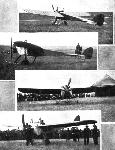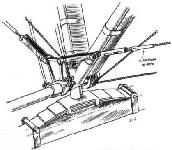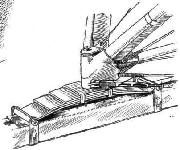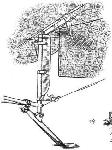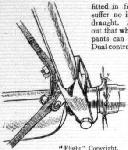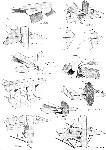
Описание
Страна: Великобритания
Год: 1912
C.Andrews Vickers Aircraft since 1908 (Putnam)
<...>
Extensive redesign was introduced in the No. 6 monoplane, built at Erith in June 1912 for the Military Aeroplane Trials Competition, held on Salisbury Plain that year by the War Office. In the No. 6 the wing span was reduced and the undercarriage simplified by the adoption of a two-wheel arrangement with one central skid. Crew seating was side by side, which led to the unofficial designation of the monoplane as the Vickers Sociable. One of the requirements of the Competition was that both members of the crew should be provided with the best possible view of the ground in a forward arc, as the aeroplane was regarded then mainly as an instrument for supporting reconnaissance by cavalry.
No. 6 was powered by a 70 hp Viale seven-cylinder air-cooled radial engine, but this proved too unreliable to give the aeroplane a reasonable chance in the Competition, in which it was flown by L. F. Macdonald, Vickers' pilot. From this type a two-seat biplane was developed and test flown from Joyce Green in December 1912. It was in this aircraft that Macdonald, with his mechanic H. England, crashed in the Thames on 13 January, 1913, both occupants being drowned. The accident was attributed to failure of the 70 hp Gnome rotary engine, which type of engine had previously replaced the Viale in No. 6. No photographs or drawings have survived of this biplane conversion.
<...>
No. 8, the last of the early monoplanes built, reverted to the configuration of No. 6, with a 70 hp or 80 hp Gnome rotary engine as power. It was displayed at the Fourth International Aero Show at Olympia in February 1913. At the next Aero Show, also at Olympia in 1914, Vickers showed a two-seat scout biplane of wooden construction which was obviously a development of the earlier biplane of 1913. Here again few details were released, except that its estimated speed was 100 mph. Presumably this design was dropped in favour of the development of the Vickers Gunbus, which had become a priority for active service.
The following extract is taken from Flight for February 1913, and is a description of the typical construction of the Vickers monoplanes, couched in the terminology of the period. It refers to No. 8 as exhibited in the Aero Show of that year.
'The 80 hp Vickers Two-seater Monoplane - This monoplane is of the same type as the one which, fitted with a 70 hp stationary Viale motor, put up such praiseworthy flights at the time of the Military Aeroplane Competitions in August last. The identical machine shown, driven by a 70 hp Gnome motor, has done upwards of 500 miles in the air at the Vickers private flying ground at Erith, piloted by the late Mr Leslie Macdonald and by their present pilot instructor, Mr Barnwell.
'Its body is an all-steel structure, built lattice-girder fashion, with light tubular longitudinals and tubular cross members. They are assembled by means of welded steel sockets, the joints being afterwards sweated together and pinned. At the front end the four longitudinals meet in a flat upright prate, which serves as one of the mounting plates of the motor. Further support for the motor is provided by a stout flanged plate arranged some little distance behind the front cap. Seats are provided for the pilot and passenger side by side, and there are transparent wind shields fitted in front of them, so that they may suffer no inconvenience from the propeller draught. So carefully has this been carried out that when the machine is flying the occupants can detect scarcely any wind at all. Dual control is fitted. The seats are arranged well forward in the body, so that the occupants have a good clear view over the leading edge of the wings. To still further increase their range of vision, Cellon windows are let into the sides of the body. An interesting fitting in the cockpit is a Clift anti-drift compass, which is mounted over a hole in the floor and by which the machine may be kept on a true course in a side wind.
'The landing chassis is of the central skid and double wheel type. Two Vs of stout steel tube support the body from a long ash skid, which is curved up in front and which is armoured by the application of Duralumin sheeting. Two axles, carrying the rolling wheels, extend on either side of the skid. Landing shocks are absorbed by elastic springs in tension.
'The wings are built about two tubular steel spars cored with wood. Over them the ash ribs are loosely fitted in such a manner that continual warping of the wings does not tend to weaken them in any way. On the under side of the wings three stranded steel cables proceed to each spar, and these take the main lift. In a similar manner the wings are braced from above to a cabane above the pilot's cockpit.
'The tail is formed by the splaying out of the body at the rear to give a fixed stabilising surface behind which are hinged the two lifting flaps. On this monoplane, as distinct from the one that flew in connection with the Military Competitions at Salisbury, a vertical fin is fitted, which precedes an unbalanced directional rudder. A small steel skid protects the tail unit, but it is probable that it very seldom comes into play, for most of the weight of the tail on landing is taken by the backward laminated extension of the main landing skid.
'Fitted with an engine of 70 hp this monoplane shows a speed of 63 mph, and is capable of climbing with the useful load aboard of pilot, passenger, and sufficient fuel for a 3 1/2-hours' flight at the rate of 250 ft per minute. With an 80 hp Gnome motor installed, the machine has been timed to attain and maintain a speed of over 70 mph.'
The early Vickers monoplanes, supported by three Vickers Boxkites of Farman biplane genus, earned their keep despite the hazards of their low-powered engines of dubious reliability and the local physical obstructions to low-altitude flying at Brooklands in the wooded uplands of nearby St George's Hill and Weybridge Heath. There was also the notorious sewage farm, located inside the motor-racing track towards the railway embankment, ready to receive into its sticky mire the unwary flier in trouble on take-off or approach. The monoplanes competed in the popular flying meetings held at Brooklands in pre-1914 days and were always prominent in the handicap races flown on a circuit out to Coxes Lock Mill, near Addlestone, and back. Those halcyon afternoons of real peacetime aeronautics are fast fading from living memory.
Vickers Flying School at Brooklands trained 77 pupils between 1912 and 1914, the second highest of all the civilian schools in the country, and was only bettered by the Bristol School, who also trained most of their pupils at Brooklands. From January to August 1914, when Vickers School closed down because of the outbreak of war, it produced 36 pilots with aviators' certificates - popularly known as flying tickets. This was the record for the country, and the list of Vickers pupils contained names of pilots who achieved fame later on. The work of the pre-1914 civilian flying schools contributed much to the air services by way of trained pilots in the critical early period of the first world war.
Meanwhile Vickers went on with their development of metallised airframes as pioneered by the R.E.P. type monoplanes and with the evolution of a gun-carrying pusher biplane as well as various attempts to find a satisfactory alternative engine to the ubiquitous Gnome.
Monoplanes Nos. 1-7
Nos 1, 2 and 3 No. 6 No. 7
Accommodation: Pilot and passenger Pilot and passenger Pilot and passenger
Engine: 60 hp R.E.P.* 70 hp Viale** 100 hp Gnome
Span: 47 ft 6 in 35 ft 34 ft 6 in
Length: 36 ft 5 in - 25 ft
Wing Area: 290 sq ft 220 sq ft 220 sq ft
Empty Weight: 1,000 lb - 730 lb
Gross Weight: - - 1,200 lb
Max Speed
at Ground Level: 56 mph 63 mph 70 mph
Range: - - 350 miles
* Changed to 60 hp Vickers-REP on No. 2.
** Changed to 70 hp Gnome rotary.
Описание:
- C.Andrews Vickers Aircraft since 1908 (Putnam)
- M.Goodall, A.Tagg British Aircraft before the Great War (Schiffer)
- P.Lewis British Aircraft 1809-1914 (Putnam)
- Jane's All The World Aircraft 1913
- Журнал Flight
Фотографии
-
M.Goodall, A.Tagg - British Aircraft before the Great War /Schiffer/
Vickers No. 6 monoplane with Viale engine at the War Office Military Aeroplane Trials in 1912 at Larkhill, Salisbury Plain.
-
Журнал - Flight за 1912 г.
The Vickers monoplane, fitted with 70-h.p. Viale engine, piloted by Macdonald in the Army Aeroplane Competition on Salisbury Plain.
-
M.Goodall, A.Tagg - British Aircraft before the Great War /Schiffer/
Vickers No.VI monoplane was a major redesign with side-by-side seating.
-
Jane's All The World Aircraft 1913 /Jane's/
No. 6 monoplane re-engined with a 70 hp Gnome and with a Levasseur-type propeller.
-
P.Lewis - British Aircraft 1809-1914 /Putnam/
Vickers No.VIII monoplane in the works at Erith. It had side-by-side seating and a 70 or 80hp Gnome engine.
-
C.Andrews - Vickers Aircraft since 1908 /Putnam/
No. 8 monoplane in Vickers Erith works, showing balanced elevators and sociable side-by-side seating first exploited in No. 6.
-
Журнал - Flight за 1913 г.
The Vickers war monoplane.
-
Журнал - Flight за 1913 г.
Mr. Barnwell In flight, with a passenger, on Vlckers No. 8 before his recent mishap down Weybrldge way.
-
C.Andrews - Vickers Aircraft since 1908 /Putnam/
No. 8 monoplane packed for field transport on trailer and complete with ground crew in Napier car.
-
Журнал - Flight за 1912 г.
A trio of Vickers monoplanes at the Vickers Brooklands School.
Другие самолёты на фотографии: Vickers No.2 - No.5, No.7 - Великобритания - 1912
-
Журнал - Flight за 1913 г.
Ready for the day's work at the Vlckers Flying School at Brooklands Aerodrome.
Другие самолёты на фотографии: Vickers No.2 - No.5, No.7 - Великобритания - 1912
-
Журнал - Flight за 1912 г.
THE VICKERS MONOPLANE.-Sketch showing the engine-mounting and landing-skid.
-
Журнал - Flight за 1912 г.
THE VICKERS MONOPLANE. - The landing-chassis.
-
Журнал - Flight за 1912 г.
THE VICKERS MONOPLANE. - Showing how the front chassis-struts are connected to the central landing-skid, and insulated therefrom by a laminated steel spring.
-
Журнал - Flight за 1912 г.
THE VICKERS MONOPLANE. - The mechanism that operates the wing-warping. Note the laminated steel spring that insulates the chassis-strut from the skid.
-
Журнал - Flight за 1912 г.
THE VICKERS MONOPLANE. - Details of the tail, showing the tailskid and release-catch.
-
Журнал - Flight за 1913 г.
A chassis detail of the Vickers monoplane.
-
Журнал - Flight за 1913 г.
VICKERS MONOPLANE DETAILS. - The sketch on the left illustrates the fitting by which the two front V-set chassis struts are assembled to the central skid. It also shows how the wing cables are attached. That on the right shows the tail.
-
Журнал - Flight за 1913 г.
The 70-h.p. Gnome-Vickers monoplane.
-
Журнал - Flight за 1913 г.
The 80-h.p. Vickers monoplane.
-
Журнал - Flight за 1913 г.
AT OLYMPIA. - A study in tail-skids.
Другие самолёты на фотографии: Avro Type E / 500 - Великобритания - 1912Bleriot Bleriot-XI-2 - Франция - 1911Caudron N - Франция - 1911Cody No.5 - Великобритания - 1912Deperdussin Racer - Франция - 1912Farman HF.15/16/20 - Франция - 1912Grahame-White Type VI military - Великобритания - 1913Handley Page Type E / H.P.5 - Великобритания - 1912Martin & Handasyde Model of 1912 year - Великобритания - 1912Maurice Farman MF.7 Longhorn - Франция - 1912RAF B.E.2/B.E.2a/B.E.2b - Великобритания - 1912Sopwith Three-Seater - Великобритания - 1913Vickers EFB.1 - Великобритания - 1913
-
Журнал - Flight за 1913 г.
A study in tails.
Другие самолёты на фотографии: Avro Type E / 500 - Великобритания - 1912Caudron N - Франция - 1911Cody No.5 - Великобритания - 1912Farman HF.15/16/20 - Франция - 1912Grahame-White Type VI military - Великобритания - 1913Grahame-White Type VIII hydro - Великобритания - 1913Martin & Handasyde Model of 1912 year - Великобритания - 1912Maurice Farman MF.7 Longhorn - Франция - 1912Short S.41 seaplane - Великобритания - 1912Wight No.1 Seaplane - Великобритания - 1913


